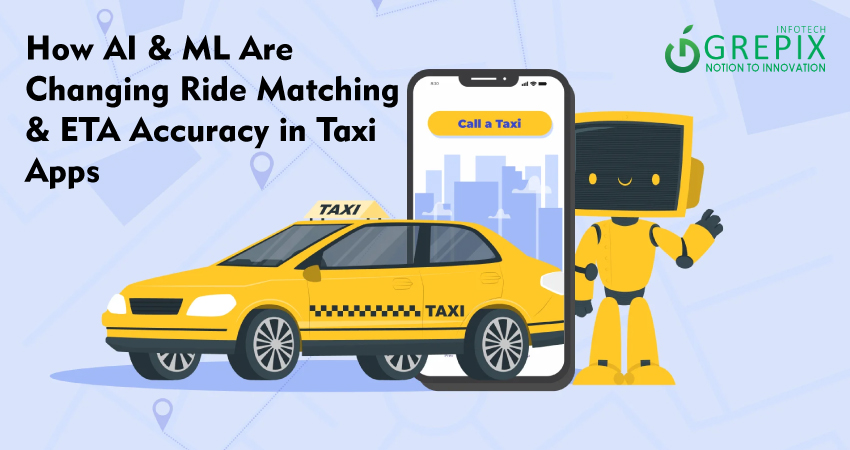How AI & ML Are Changing Ride Matching & ETA Accuracy in Taxi Apps
AI and machine learning have completely revolutionized how modern taxi apps manage ride matching and ETA prediction, transforming urban mobility through smarter, faster, and more reliable services. Powered by vast data and predictive models, features such as ride matching AI, machine learning ETA prediction, and smart taxi app features now define leading taxi apps worldwide. This comprehensive guide explores the applications, benefits, future innovations, and practical strategies to help any mobility business thrive in a data-driven era.
Smart taxi apps now leverage AI and machine learning to revolutionize ride matching and ETA accuracy, transforming how users hail rides and plan journeys. By employing machine learning in ETA prediction and AI-driven ride matching, taxi apps like Uber and Careem have dramatically reduced wait times, optimized driver allocation, and improved user satisfaction. Real-life case studies reveal up to 30% reductions in wait times and significant drop in cancellations. Features like smart route planning, dynamic pricing, and real-time customer support deliver a seamless urban mobility experience. As the industry advances, businesses integrating these smart features will achieve higher ratings, competitive advantages, and operational scalability. Discover why adopting AI in taxi apps is no longer optional it’s the way forward for future proof success.
How AI in Taxi Apps & Machine Learning ETA Prediction Reshape Ride-Hailing
Introduction
Urban mobility is undergoing a rapid transformation, with AI in taxi apps leading the change. Machine learning ETA prediction and ride matching AI are responsible for smarter, more personalized, and efficient journeys. Users now expect instant bookings, precise ETAs, and reliable matches a feat achieved only through the seamless integration of advanced technologies. This article explains how machine learning ETA prediction and other smart taxi app features solve longstanding pain points and empower both riders and drivers.
AI in Ride Matching: Smarter, More Reliable Connections
How Ride Matching AI Works
Modern ride matching AI doesn’t just find the nearest taxi; it weighs dozens of factors to select the best driver. Algorithms consider driver ratings, proximity, vehicle type, current traffic, and predicted acceptance likelihood, ensuring each match leads to a successful transaction.
- Smart ride matching uses clustering and graph-based optimization for real-time pairing.
- Machine learning analyzes booking history, preferences, and external data like weather or local events.
- For shared rides (UberPool, Lyft Line), multi-rider optimization ensures cost-effectiveness and low wait times.
Real-Life Example: Uber’s Algorithmic Engine
Uber’s dispatch engine processes over 30 million match pairs per minute, using machine learning to optimize matches, cut wait times, and improve user satisfaction. Lyft and Careem also deploy advanced ride matching AI, reducing ride cancellations by up to 18% in certain regions.
Machine Learning ETA Prediction: Precision at Scale
What is Machine Learning ETA Prediction?
Traditional ETA calculations use static routing algorithms, which fail to account for real-world variables like sudden traffic jams, construction, or accidents. Today, machine learning ETA prediction models break this barrier:
- Hybrid approaches use routing engine outputs (“base ETA”) plus real-time features to calculate residual changes and deliver highly accurate ETAs.
- Features include origin and destination data, time of request, driver speed, road segment stats, live traffic, and even weather.
Case Study: Uber’s DeepETA
Uber’s proprietary DeepETA system incorporates neural networks trained on billions of real trip records, enabling continuous ETA updates. This “machine learning ETA prediction” technique reduces wait times by up to 30%, boosts reliability, and decreases trip cancellations across busy metropolitan environments.
Statistics: The Value of Accurate ETAs
- ETA accuracy directly correlates to improved customer satisfaction and reduced ride cancellations.
- Machine learning-driven ETA updates can mitigate fare disparities and enhance trip planning efficiency for users and service providers.
Smart Taxi App Features: Value for Riders and Drivers
Essential Features Enabled by AI
- Dynamic pricing models: Fair, on-the-fly fare adjustments using demand forecasting, weather, and local events.
- Route optimization: Live rerouting to avoid congestion and lower travel times, saving fuel and wear.
- Personalized experiences: Ride matching AI adapts to user preferences, vehicle types, and even music choices.
- Safety assurance: Fraud detection algorithms, biometric verification, and real-time safety alerts are now standard.
- AI-powered support: Intelligent chatbots resolve queries and disputes instantly without human intervention.
- Driver performance monitoring:Machine learning assesses driving habits, rewards top performers, and encourages improvement.
Implementation Strategies for Businesses
- Define and prioritize AI goals focus on core areas like route planning and ETA prediction.
- Use pre-trained machine learning models for speed and reliability.
- Partner with data providers for live traffic, event, and weather data.
- Invest in robust real-time analytics infrastructure.
- Start with limited AI features, conduct A/B testing, then scale up.
Benefits of AI & ML in Taxi Apps
For Riders:
- Shorter ETAs and wait times
- Greater reliability in predictions
- Personalization of options
- Improved safety
For Drivers & Fleet Operators:
- Smarter allocation lowers idle time
- Dynamic earnings based on demand surges
- Performance feedback leads to better ratings
- Reduced cancellations and increased job satisfaction
For Taxi Businesses:
- Higher ratings and brand trust
- Optimized dispatch lowers costs
- Scalable operations up to half a million requests/second (Uber)
- Resilience through data-driven, adaptive algorithms
- Competitive edge in crowded urban markets
Future Innovations: Where Is AI in Taxi Apps Going?
Autonomous Vehicles & IoT Integration
- Self-driving taxis (Waymo, Tesla, Uber partnerships) will leverage AI for full automation and real-time traffic management.
- IoT sensors will offer predictive maintenance, monitor fleet health, and adapt to emerging urban challenges.
Generative AI & Smart Assistants
- AI-powered virtual agents will book rides, handle customer support, and predict transportation needs proactively.
- Hyper-personalized mobility services, integrating across apps and devices.
Data Monetization & Platform Expansion
- Taxi platforms will commercialize their real-time movement data for smart city planning and logistics.
- AI in taxi apps will expand to freight, courier, and autonomous delivery domains, reshaping the competitive landscape.
Conclusion
AI and machine learning are not just buzzwords they’re the foundation of modern taxi app success. By using ride matching AI, machine learning ETA prediction, and smart taxi app features, companies deliver unmatched convenience, reliability, and personalization. Real-life examples like Uber, Careem, and Lyft reveal that data-driven apps reduce wait times, optimize routes, and build lasting trust. As urban mobility evolves, the businesses embracing AI in their taxi apps will become tomorrow’s leaders. Take action now—adopt AI for smarter apps, boost ratings, and future-proof your taxi service. Share this guide with decision-makers to accelerate your transformation and empower the mobility revolution.
FAQs
1. What is ride matching AI in taxi apps?
Ride matching AI refers to machine learning algorithms that instantly pair riders and drivers based on dozens of real-time factors, such as location, driver ratings, predicted acceptance, and traffic conditions.
2. How does machine learning improve ETA prediction?
Machine learning models consider routing outputs and real-time variables like traffic, weather, and driver speed to deliver highly accurate ETAs, reducing rider wait times and cancellations.
3. Can small taxi apps adopt these smart features?
Yes! Taxi app clones and startups can leverage pre-trained models, partner for data, and start with core smart features like intelligent matching and dynamic pricing then gradually scale up.
4. Are smart taxi app features safe and compliant?
Modern smart taxi app features use biometric verification, fraud detection, and privacy filters to keep users safe while respecting regional regulations.
5. What future innovations can we expect in AI taxi apps?
Expect integration with autonomous vehicles, predictive maintenance through IoT, hyper-personalized AI mobility assistants, and smarter city logistics powered by platform data.







